英國倫敦T Cribb & Sons殯儀館於1881年創立,旗下「國家葬禮博物館」(National Funeral Museum)與《追新聞》聯乘,介紹英國傳統殯葬文化。
死亡,時至今日都被視作禁忌。英國維多利亞時代,死亡幾乎是日常生活的一部份,守喪悼念更成為習俗。奢華的葬禮,也是當時報章、雜誌和書籍的討論焦點;死亡文化,更影響着英國每一個人,當中包括孩童。
英國以至世界各地為保護兒童,將他們遠離悼念和葬禮。維多利亞時代的英國人,反而鼓勵孩子參與殯葬儀式。大人會攜帶孩子出席至親的葬禮,讓他們穿上黑色或白色衣服,送別親人最後一程。
更重要的是,童書也毫不避忌談論死亡,其中一首英國耳熟能詳的童謠——《埋葬知更鳥》(The Death and Burial of Cock Robin),或稱為《誰殺了知更鳥》(Who Killed Cock Robin?),就是講述知更鳥遭麻雀「用弓箭」謀殺,牠的朋友商量如何為其舉行葬禮的故事。這首童謠追溯至1744年,收集在英國流行歌藏書內,但歷史學家認為,這首童謠應該擁有更悠久的歷史。在15世紀的彩繪琉璃窗,就有知更鳥被弓箭射殺的繪圖,相似童謠故事的橋段,也與英皇威廉二世於1100年在狩獵時離奇遭一箭穿心而死的過程相似,也聯想到諾斯–塞爾特人(Norse and Celtic)夏至冬來、迎接收穫節的神話。
《埋葬知更鳥》提到「誰做裹屍布」(make the shroud),也討論誰來扶靈的細節,然後就是葬禮過程,步入教堂、挖掘墳墓、唱聖詩,以及由神職人員主持葬禮,每一環節都遵從基督徒的送葬儀式。
童謠無需教導孩童「如何」舉行葬禮,反而讓他們認識死亡和葬禮與日常生活息息相關。除了《埋葬知更鳥》外,另外兩本童書《三隻小貓的葬禮》(The Death and Burial of the Three Little Kittens)、《留給孩子的紀念》(A Token for Children)也不忌諱死亡,父母透過故事向孩童教導虔誠和服從。
由於維多利亞時期的嬰兒夭折率高,每年超過10萬嬰兒未能渡過1歲生辰,,原因不外乎是貧困的居住環境,以及感染無藥可醫的傳染病。為了送別至愛的兒子和女兒,兒童葬禮通常用使用白色棺木、白色圍巾和白色手套。
時至今日的英國,隨着醫療進步和生活質素提升,有父母為着保護兒童遠離死亡和哀悼,但仍然有很多兒童孜孜不倦欲了解死亡、守喪、葬禮等文化,透過閱讀《誰殺死知更鳥》就可以打開禁忌的話匣子了。
倫敦國家葬禮博物館策展人
Minette Butler
(詳見【英文版】)
Burying Cock Robin: A Morbid Victorian Nursery Rhyme
In many parts of the world today, death is a taboo that is very rarely discussed in public. But in Victorian Britain, death was part of everyday life. Mourning customs such as dressing in black, wearing mourning jewellery and hosting lavish funerals were seen on streets and discussed in newspapers, magazines and books. This culture of death affected everyone – even children.
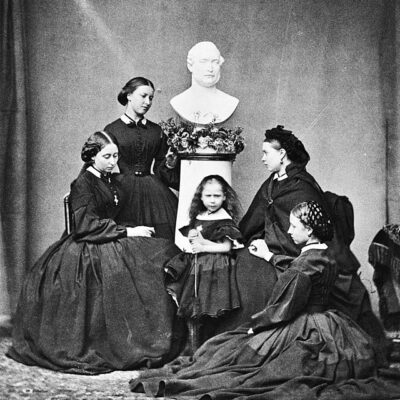
※ Queen Victoria youngest daughter Beatrice in the centre in mourning for her father. ※ 小公主Beatrice出席送別父親的喪禮。(Credit:National Funeral Museum Collection 倫敦國家葬禮博物館收藏 )
Though many in Britain and around the world may choose to shelter young people from the realities of grief and funerals, Victorians actively encouraged their children to take part in their mourning rituals. Children were brought to visit the bodies of family and friends. They attended funerals and, if they lost a relative, they would go into mourning by wearing black or white clothes with the rest of their family.
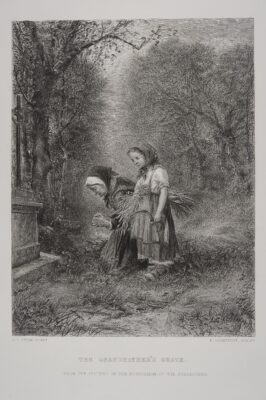
※ Child Visiting a Grandfather’s Grave ※ 孩童為祖父的墳頭掃墓。 (Credit:National Funeral Museum Collection 倫敦國家葬禮博物館收藏 )
But more than this, children’s media did not shy away from the realities of death and funerals, particular children’s books. One example of this is a popular English Nursery Rhyme, generally known by the title “The Death and Burial of Cock Robin” – also known as “Who Killed Cock Robin?”. This book tells the story of a robin that is murdered by a sparrow “with a bow and arrow”, and his friends decide to arrange a funeral for him.
The nursery rhyme dates back at least to 1744, where it is printed in a collection of popular English songs. However, like a lot of stories, historians think that Cock Robin is probably a lot older. A 15th century stained glass window depicts a robin killed by an arrow, and the nursery rhyme tells a similar story to the English King William II, who died mysteriously from a stray arrow in 1100. There are also stories from Norse and Celtic Mythology about important deaths at the hands of arrows and birds.
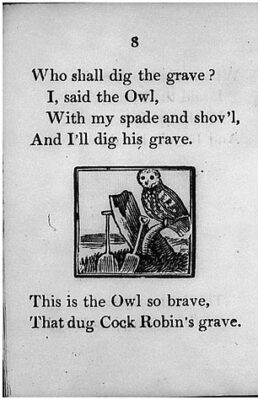
※ Who shall dig the grave I said the owl – wikimedia commons 1820 ※誰挖墓地?(Credit:National Funeral Museum Collection 倫敦國家葬禮博物館收藏 )
Though the nursery rhyme’s exact order and content has changed over hundreds of years, the main narrative has remained the same. The story includes a narrator asking a series of questions about who will carry out certain parts of the funeral service. The book almost becomes a guide on how to hold a typical English countryside funeral, with various animals like ducks, beetles, owls and doves volunteering to take on traditional roles.
The poem asks who will “make the shroud”, a type of grave clothing usually made from linen and wrapped around the body after it had been washed and prepared. The story also asks who will “carry the coffin” and invites people to “bear the pall” – a large piece of black or dark velvet that traditionally covered the coffin. Family members were often invited to carry the edge of the pall as they walked to the church during funeral processions. It also lists the duties to “dig the grave”, “sing the psalm” and “be the parson” or priest- all essential parts of the Christian burial service.
The poem goes on. It asks “who will be chief mourner?”, referring to the deceased person’s closest living relative or friend who took on a leading role in the ceremony. It asks “who will carry the link?” – a lit torch held at the head of the procession to light the way to the church, particularly during funerals that took place at night. Finally, it concludes by asking “who will ring the bell?” – referring either to the “lich” or “corpse bell” that was rung as the procession walked to the burial service, or to the bigger “church” bell, rung slowly soon after a member of the parish or village had died.
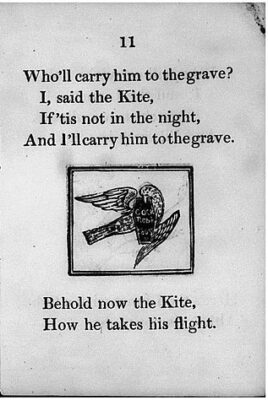
※ Who’ll carry him to the grave wikimedia commons 1820 ※誰將他送入墳墓?(Credit:National Funeral Museum Collection 倫敦國家葬禮博物館收藏 )
Cock Robin was a popular children’s book right up to the end of the 19th century – producing many new editions that were read by parents to their sons and daughters in nurseries and before bedtime. Most of these editions included elaborate illustrations that show the funeral taking place – complete with the coffin, open grave and mourners dressed in black. The story was also a popular topic for prints and paintings that were used to decorate people’s homes, and even inspired many taxidermy dioramas that depicted the various animals carrying out the funeral procession.
The point of this nursery rhyme was not necessarily to teach children “how” to hold a funeral. Instead, it was one of many ways that the realities of death and burial were integrated into everyday life. As well as “Cock Robin”, books like “The Death and Burial of the Three Little Kittens” – another entertaining story about the funeral of three popular children’s characters – were common stories found in nurseries and school rooms illustrated with bright pictures that helped amuse and teach children to read. The book “A Token for Children”, first published in 1670, tells the story of the “Holy and Exemplary lives and Joyful Deaths” of thirteen different children. The book was still in print in 1875, and parents read this to their young to encourage them to be pious and obedient.
The stories about children’s lives and deaths were part of everyday life in other ways. Popular songs like “Little Sister’s Gone to Sleep”, telling the story of the death of a younger sibling, were sung around the piano, and children were encouraged to learn prayers that comforted them after the loss of family members.
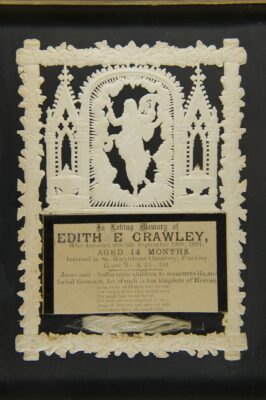
※14-month old Edith’s grave ※ 1891年送別14個月大女兒的紀念碑。(Credit:National Funeral Museum Collection 倫敦國家葬禮博物館收藏 )
Though this easy interaction with tragedy and morbidity may seem foreign and macabre, it makes sense when placed in the context of Victorian Britain. The 19th century is infamous for its high infant mortality rate. The tragic deaths of babies and children were experienced by all classes, especially by the poor. In Victorian Britain, it is estimated that over 100,000 children a year would die before their first birthday, mainly due to poor living conditions and the amount of then untreatable infectious diseases.
Victorians felt the loss of their children as much as any parent would today. In fact, in a culture of conspicuous mourning, some of the most famous and beautiful tributes to the dead were made in memory of lost sons and daughters. Children’s funerals were specially furnished with white coffins, scarves and gloves, and their lives were remembered with trinkets like mourning jewellery, mourning cards and even post mortem photographs, taken of their bodies to preserve their image forever.
Meanwhile, with infant mortality so high, most children would have lost friends or siblings by the time they were twelve years old. In their memory, children would have worn mourning dress, attended their funerals and visited their graves. For them death was not something remote or taboo but an ever present part of their daily lives.
In Britain today, infant mortality has drastically dropped thanks to the rise of healthcare and living standards. Some feel this has led parents to shelter their children from the realities of death and grief. Though many children still enjoy books with grim or taboo subjects, stories like “Who Killed Cock Robin?” stand out today for their frank and even morbid exploration of death, mourning and funerals.
Minette Butler – Curator, National Funeral Museum
倫敦國家葬禮博物館(National Funeral Museum)
Twitter: @nfmtcribb
Instagram: @nationalfuneralmuseum
地址:T Cribb & Sons, Victoria House, Beckton, E6 5PA
開放時間:周一至五,上午9時至下午5時
歡迎團體或個人預約,館方安排免費導賞服務,請電郵至nfm@tcribb.co.uk



